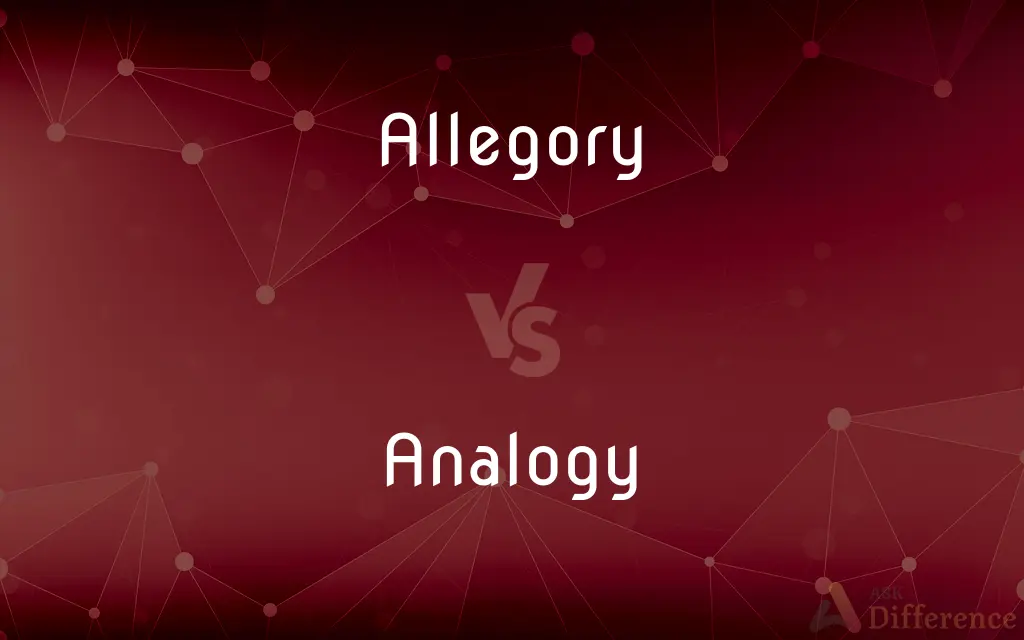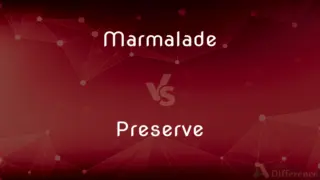Allegory vs. Analogy — What's the Difference?
By Tayyaba Rehman — Updated on November 2, 2023
Allegory is a narrative with a symbolic meaning, while analogy is a comparison highlighting similarities between two different things.

Difference Between Allegory and Analogy
Table of Contents
ADVERTISEMENT
Key Differences
An allegory is a complete narrative that conveys complex ideas through symbolic figures and actions. It operates on a dual level of meaning – the literal events in the story and the symbolic meanings they represent. An analogy, by contrast, is a simple comparison used to explain or highlight similarities between two different things.
Allegories often involve sustained metaphors throughout a work, while analogies are typically shorter, isolated comparisons. "Animal Farm" by George Orwell is an example of an allegory, using a farm to represent the events leading up to the Russian Revolution and the early Soviet Union. An analogy, on the other hand, could be as simple as saying that the brain is like a computer, comparing two distinct objects to explain the function of one.
An allegory tends to have a more profound, often moral or philosophical, lesson implied within its storytelling. It is intentionally crafted to convey a deeper meaning often reflective of human experience or societal structures. An analogy is more of a tool for clarification, helping to explain a concept or idea by likening it to something more familiar to the audience.
The usage of allegory is often found in literature, art, and film, whereas analogy is commonly utilized in everyday language, teaching, and argumentation to make a concept more comprehensible or relatable. Allegory is an extended metaphor, while an analogy is more of a logical argument.
An allegory often requires interpretation and thought to uncover the hidden meanings, inviting readers or viewers to explore the underlying message. An analogy serves to bridge understanding quickly and does not necessarily have a deeper layer of meaning beyond the surface comparison.
ADVERTISEMENT
Comparison Chart
Definition
A symbolic narrative with deeper meaning.
A comparison explaining similarities.
Purpose
To convey complex ideas symbolically.
To clarify or illustrate a point.
Length
Extended throughout a work.
Usually brief and specific.
Usage
Literature, art, film.
Everyday language, education, arguments.
Interpretation
Requires analysis to understand hidden layers.
Direct and straightforward for clarity.
Compare with Definitions
Allegory
Extended metaphor in storytelling.
His allegory painted a bleak picture of a dystopian future.
Analogy
A comparison to show similarities.
He used an analogy of a tree's roots to explain family heritage.
Allegory
A narrative technique for conveying complex ideas.
The director's film is an allegory for freedom.
Analogy
A bridge between familiar and unfamiliar ideas.
Her analogy linked the atom's structure to a solar system.
Allegory
A work that uses symbolism to express a deeper message.
The allegory disguised its criticism of society in fantasy.
Analogy
Illustration by parallel case.
His speech used an analogy comparing life choices to crossroads.
Allegory
As a literary device, an allegory is a narrative in which a character, place, or event is used to deliver a broader message about real-world issues and occurrences. Authors have used allegory throughout history in all forms of art to illustrate or convey complex ideas and concepts in ways that are comprehensible or striking to its viewers, readers, or listeners.
Analogy
Reasoning from parallel facts.
The lawyer drew an analogy between two similar cases.
Allegory
A story, poem, or picture that can be interpreted to reveal a hidden meaning, typically a moral or political one
Pilgrim's Progress is an allegory of the spiritual journey
Analogy
A tool for explaining concepts.
The teacher's analogy made the math problem easier to understand.
Allegory
The representation of abstract ideas or principles by characters, figures, or events in narrative, dramatic, or pictorial form.
Analogy
Analogy (from Greek ἀναλογία, analogia, "proportion", from ana- "upon, according to" [also "against", "anew"] + logos "ratio" [also "word, speech, reckoning"]) is a cognitive process of transferring information or meaning from a particular subject (the analog, or source) to another (the target), or a linguistic expression corresponding to such a process. In a narrower sense, analogy is an inference or an argument from one particular to another particular, as opposed to deduction, induction, and abduction, in which at least one of the premises, or the conclusion, is general rather than particular in nature.
Allegory
A story, picture, or play employing such representation. John Bunyan's Pilgrim's Progress and Herman Melville's Moby-Dick are allegories.
Analogy
A comparison between one thing and another, typically for the purpose of explanation or clarification
He interprets logical functions by analogy with machines
An analogy between the workings of nature and those of human societies
Allegory
A symbolic representation
The blindfolded figure with scales is an allegory of justice.
Analogy
A similarity in some respects between things that are otherwise dissimilar
Sees an analogy between viral infection and the spread of ideas.
Allegory
(rhetoric) A narrative in which a character, place, or event is used to deliver a broader message about real-world issues and occurrences.
Analogy
A comparison based on such similarity
Made an analogy between love and a fever.
Allegory
A picture, book, or other form of communication using such representation.
Analogy
(Biology) Correspondence in function or position between organs of dissimilar evolutionary origin or structure.
Allegory
A symbolic representation which can be interpreted to reveal a hidden meaning, usually a moral or political one.
Analogy
A form of reasoning based on the assumption that if two things are known to be alike in some respects, then they are probably alike in other respects.
Allegory
A category that retains some of the structure of the category of binary relations between sets, representing a high-level generalisation of that category.
Analogy
(Linguistics) The process by which words or morphemes are re-formed or created on the model of existing grammatical patterns in a language, often leading to greater regularity in paradigms, as evidenced by helped replacing holp and holpen as the past tense and past participle of help on the model of verbs such as yelp, yelped, yelped.
Allegory
A figurative sentence or discourse, in which the principal subject is described by another subject resembling it in its properties and circumstances. The real subject is thus kept out of view, and we are left to collect the intentions of the writer or speaker by the resemblance of the secondary to the primary subject.
Analogy
A relationship of resemblance or equivalence between two situations, people, or objects, especially when used as a basis for explanation or extrapolation.
Allegory
Anything which represents by suggestive resemblance; an emblem.
Analogy
(geometry) The proportion or the equality of ratios.
Allegory
A figure representation which has a meaning beyond notion directly conveyed by the object painted or sculptured.
Analogy
(grammar) The correspondence of a word or phrase with the genius of a language, as learned from the manner in which its words and phrases are ordinarily formed; similarity of derivative or inflectional processes.
Allegory
A short moral story (often with animal characters)
Analogy
A resemblance of relations; an agreement or likeness between things in some circumstances or effects, when the things are otherwise entirely different. Thus, learning enlightens the mind, because it is to the mind what light is to the eye, enabling it to discover things before hidden.
Allegory
A visible symbol representing an abstract idea
Analogy
A relation or correspondence in function, between organs or parts which are decidedly different.
Allegory
An expressive style that uses fictional characters and events to describe some subject by suggestive resemblances; an extended metaphor
Analogy
Proportion; equality of ratios.
Allegory
A story with a hidden meaning.
The allegory of the cave offers insight into human perception.
Analogy
Conformity of words to the genius, structure, or general rules of a language; similarity of origin, inflection, or principle of pronunciation, and the like, as opposed to anomaly.
Allegory
Symbolic representation throughout a narrative.
Her novel is an allegory for the journey of life.
Analogy
An inference that if things agree in some respects they probably agree in others
Analogy
Drawing a comparison in order to show a similarity in some respect;
The operation of a computer presents and interesting analogy to the working of the brain
The models show by analogy how matter is built up
Analogy
The religious belief that between creature and creator no similarity can be found so great but that the dissimilarity is always greater; language can point in the right direction but any analogy between God and humans will always be inadequate
Common Curiosities
Is an allegory just a long analogy?
No, an allegory is a complete narrative with symbolic meaning, not just a comparison.
Can analogies be used in literature?
Yes, analogies can be literary devices to draw comparisons for better understanding.
How do you identify an allegory?
Look for a story with characters and events that represent broader themes or concepts.
What is a simple analogy?
A comparison of two unlike things to explain a concept, like comparing electricity flow to water in pipes.
How is an allegory different from symbolism?
Allegory is a narrative form, whereas symbolism refers to specific objects representing broader ideas.
Are analogies factual?
They are not necessarily factual but are used to explain facts or concepts in a relatable way.
Do all allegories have a moral lesson?
Most have a moral or philosophical lesson, but it's not a requirement.
Are analogies only used in teaching?
No, they are used in various contexts, including everyday conversation, to clarify ideas.
Can allegories have multiple interpretations?
Yes, allegories can have various layers of meaning and can be interpreted differently.
What is the purpose of an allegory?
To convey complex ideas, morals, or criticisms through symbolic storytelling.
Is it easy to mix up allegory and analogy?
It can be, but remembering that allegory is a narrative and analogy is a comparison helps distinguish them.
Can an analogy be considered incorrect?
Yes, if it does not accurately convey the relationship between the compared elements.
Do analogies need to be simple?
While they are often simple, complex analogies can be used in advanced academic or professional contexts.
Why are allegories important in literature?
They allow writers to discuss complex or sensitive subjects in a more palatable way.
What’s a historical example of an allegory?
John Bunyan's "Pilgrim’s Progress" is a historical allegory of the Christian journey of faith.
Share Your Discovery

Previous Comparison
Pentoxide vs. Pentaoxide
Next Comparison
Marmalade vs. PreserveAuthor Spotlight
Written by
Tayyaba RehmanTayyaba Rehman is a distinguished writer, currently serving as a primary contributor to askdifference.com. As a researcher in semantics and etymology, Tayyaba's passion for the complexity of languages and their distinctions has found a perfect home on the platform. Tayyaba delves into the intricacies of language, distinguishing between commonly confused words and phrases, thereby providing clarity for readers worldwide.
















































